On Farmland and Floodplains—Modeling Urban Growth Impacts Based on Global Population Scenarios in Pune, India
Abstract
:1. Introduction
- (1)
- Cellular Automata (CA) are today the most commonly used approaches for urban growth simulations [17,18]. Conceptualized in 1943 [19], CAs’ first real-world application in urban research dates back to Tobler’s [20] modeling of Detroit’s expansion in the 1960s. Urban CA models describe the evolution of geographical phenomena in a bottom-up approach: the state change (non-urban to urban) of each cell in the modeling landscape is determined by its former state and its neighborhood. Growth patterns emerge when a set of simple growth rules is applied to each cell individually [21].
- (2)
- Statistical approaches are often logistic regressions that predict the probability of cells to urbanize based on variables such as proximity to urban centers, infrastructure availability, and terrain [22].
- (3)
- Markov chains are stochastic models of temporal land cover and land use change, predicting the transition probability of land use classes based on their state in the previous time step and a static transition probability matrix [23]. They are often combined with other models such as logistic regression or cellular automata (CA–Markov), to include neighborhood effects and produce spatially explicit land use change maps [24,25].
- (4)
- (5)
2. Materials and Methods
2.1. Overview Urban Growth Model Suite
2.2. Study Site: Pune
2.3. Future Scenario Estimation
2.3.1. Regionalization of Demographic and Economic Scenarios
2.3.2. Estimating Future Built-Up Expansion via Beta Regression
2.4. Cellular Automaton–Built-Up Area Allocation
2.5. Dasymetric Mapping—Population Distribution over Built-Up Area
2.6. Sustainability Assessments
3. Results
3.1. Model Fitting and Calibration for Pune
3.2. Model Results Pune
4. Discussion
- (1)
- With up to 49,000 dwellers per km2, Pune’s urban core is already today extremely crowded. Our results show that its peak density will further increase, especially since the expected population growth will not distribute evenly across the metropolitan area but concentrate in the urban center and along the transportation infrastructure. In the BAU scenario, the maximum density reaches 60,000 persons/km2 by 2050 in PMC. Contrasting the population density with the built-up area population density, which does not increase, points to the need for adequate and comparable metrics. Overcrowding has been highlighted as a key challenge in Pune’s Food-Water-Energy nexus during co-creation workshops in 2019 and 2020: already today, water, electricity, and the transportation infrastructure are barely satisfying growing demands [97]. For example, the insufficient piped water network has led to the drilling of more than 100,000 borewells in the city, extracting approximately 113 million m3/year of groundwater, a fourth of the piped supply [98]. If the demand continues to outpace the municipal supply, a massive overuse of groundwater, as well as growing tanker water markets, can be expected.
- (2)
- Pune has suffered great losses during recent floods. The flood risk of a particular location depends on many factors and our analysis can only be a first approximation. We see, however, two trends potentially aggravating the situation: the significant inner-city surface sealing due to ongoing construction, and disproportionally active developments around the Mutha and Mula rivers, especially in the northern PMC. It should be noted that current or future policies to restrict development within flood-risk areas are not implemented in the model. Here, future work on the simulation of the effectiveness of different riverbank protection schemes, as well as the city’s controversial riverfront development plans, could yield valuable insights.
- (3)
- Over half of the land conversion in the BAU scenario is projected to take place on agricultural land. This is an even higher share than in the past and may exacerbate the adverse effects on local food security and rural livelihoods postulated by Garud and Rao [52]. From an ecological perspective, the sharply increasing fragmentation of the PMR’s landscape is particularly problematic due to the partitioning of habitats in the fringe area, reducing ecological connectivity [99].
5. Conclusions
Supplementary Materials
Author Contributions
Funding
Data Availability Statement
Acknowledgments
Conflicts of Interest
References
- UN DESA. World Urbanization Prospects 2018: Highlights (ST/ESA/SER.A/421). 2019. Available online: https://population.un.org/wup/Publications/Files/WUP2018-Highlights.pdf (accessed on 5 September 2022).
- Corbane, C.; Florczyk, A.J.; Pesaresi, M.; Politis, P.; Syrris, V. GHS Built-Up Grid, Derived from Landsat, Multitemporal (1975–1990–2000–2014), R2018A. 2018. Available online: http://data.europa.eu/89h/jrc-ghsl-10007 (accessed on 10 June 2022).
- Lwasa, S.; Seto, K.C.; Bai, X.; Blanco, H.; Gurney, K.R.; Kilkiş, S.; Lucon, O.; Murakami, J.; Pan, J.; Sharifi, A.; et al. Urban systems and other settlements. In Climate Change 2022: Mitigation of Climate Change. Contribution of Working Group III to the Sixth Assessment Report of the Intergovernmental Panel on Climate Change; IPCC, Ed.; Cambridge University Press: Cambridge, UK; New York, NY, USA, 2022. [Google Scholar]
- IPBES. Global Assessment Report on Biodiversity and Ecosystem Services of the Intergovernmental Science-Policy Platform on Biodiversity and Ecosystem Services; Brondizio, E.S., Settele, J., Díaz, S., Ngo, H.T., Eds.; IPBES Secretariat: Bonn, Germany, 2019. [Google Scholar]
- Güneralp, B.; Reba, M.; Hales, B.U.; Wentz, E.A.; Seto, K.C. Trends in urban land expansion, density, and land transitions from 1970 to 2010: A global synthesis. Environ. Res. Lett. 2020, 15, 44015. [Google Scholar] [CrossRef]
- Follmann, A.; Willkomm, M.; Dannenberg, P. As the city grows, what do farmers do? A systematic review of urban and peri-urban agriculture under rapid urban growth across the Global South. Landsc. Urban Plan. 2021, 215, 104186. [Google Scholar] [CrossRef]
- Cao, W.; Zhou, Y.; Güneralp, B.; Li, X.; Zhao, K.; Zhang, H. Increasing global urban exposure to flooding: An analysis of long-term annual dynamics. Sci. Total Environ. 2022, 817, 153012. [Google Scholar] [CrossRef] [PubMed]
- Dodman, D.; Hayward, B.; Pelling, M.; Broto, V.C.; Chow, W.; Chu, E.; Dawson, R.; Khirfan, L.; McPhearson, T.; Prakash, A.; et al. Cities, Settlements and Key Infrastructure. In Impacts, Adaptation, and Vulnerability. Contribution of Working Group II to the Sixth Assessment Report of the Intergovernmental Panel on Climate Change; IPCC, Ed.; Cambridge University Press: Cambridge, UK; New York, NY, USA, 2022. [Google Scholar]
- Avashia, V.; Garg, A. Implications of land use transitions and climate change on local flooding in urban areas: An assessment of 42 Indian cities. Land Use Policy 2020, 95, 104571. [Google Scholar] [CrossRef]
- Seto, K.C.; Güneralp, B.; Hutyra, L.R. Global forecasts of urban expansion to 2030 and direct impacts on biodiversity and carbon pools. Proc. Natl. Acad. Sci. USA 2012, 109, 16083–16088. [Google Scholar] [CrossRef] [Green Version]
- Chen, G.; Li, X.; Liu, X.; Chen, Y.; Liang, X.; Leng, J.; Xu, X.; Liao, W.; Qiu, Y.; Wu, Q.; et al. Global projections of future urban land expansion under shared socioeconomic pathways. Nat. Commun. 2020, 11, 537. [Google Scholar] [CrossRef] [Green Version]
- O’Neill, B.C.; Kriegler, E.; Ebi, K.L.; Kemp-Benedict, E.; Riahi, K.; Rothman, D.S.; van Ruijven, B.J.; van Vuuren, D.P.; Birkmann, J.; Kok, K.; et al. The roads ahead: Narratives for shared socioeconomic pathways describing world futures in the 21st century. Glob. Environ. Change 2017, 42, 169–180. [Google Scholar] [CrossRef] [Green Version]
- Triantakonstantis, D.; Mountrakis, G. Urban Growth Prediction: A Review of Computational Models and Human Perceptions. J. Geogr. Inf. Syst. 2012, 4, 555–587. [Google Scholar] [CrossRef] [Green Version]
- Musa, S.I.; Hashim, M.; Reba, M. A review of geospatial-based urban growth models and modelling initiatives. Geocarto Int. 2017, 32, 813–833. [Google Scholar] [CrossRef]
- Kim, Y.; Newman, G.; Güneralp, B. A Review of Driving Factors, Scenarios, and Topics in Urban Land Change Models. Land 2020, 9, 246. [Google Scholar] [CrossRef]
- Li, X.; Gong, P. Urban growth models: Progress and perspective. Sci. Bull. 2016, 61, 1637–1650. [Google Scholar] [CrossRef]
- Tong, X.; Feng, Y. A review of assessment methods for cellular automata models of land-use change and urban growth. Int. J. Geogr. Inf. Sci. 2020, 34, 866–898. [Google Scholar] [CrossRef]
- Chang, N.-B.; Hossain, U.; Valencia, A.; Qiu, J.; Kapucu, N. The role of food-energy-water nexus analyses in urban growth models for urban sustainability: A review of synergistic framework. Sustain. Cities Soc. 2020, 63, 102486. [Google Scholar] [CrossRef]
- Von Neumann, J.; Burks, A.W. Theory of Self-Reproducing Automata; University of Illinois Press: Urbana, IL, USA, 1966. [Google Scholar]
- Tobler, W.R. A Computer Movie Simulating Urban Growth in the Detroit Region. Econ. Geogr. 1970, 46, 234–240. [Google Scholar] [CrossRef]
- Liu, Y.; Batty, M.; Wang, S.; Corcoran, J. Modelling urban change with cellular automata: Contemporary issues and future research directions. Prog. Hum. Geogr. 2019, 45, 030913251989530. [Google Scholar] [CrossRef]
- Verburg, P.H.; Soepboer, W.; Veldkamp, A.; Limpiada, R.; Espaldon, V.; Mastura, S.S.A. Modeling the spatial dynamics of regional land use: The CLUE-S model. Environ. Manag. 2002, 30, 391–405. [Google Scholar] [CrossRef]
- Mendbayar, O.; Badarifu; Ranatunga, T.; Onishi, T.; Hiramatsu, K. Cellular Automata Modelling Approach for Urban Growth. Rev. Agric. Sci. 2018, 6, 93–104. [Google Scholar] [CrossRef] [Green Version]
- Yadav, P.; Deshpande, S.S.; Ladha, S.; Curry, E. Computational Model for Urban Growth Using Socioeconomic Latent Parameters. In ECML PKDD 2018 Workshops: Nemesis 2018, UrbReas 2018, SoGood 2018, IWAISe 2018, and Green Data Mining 2018, Dublin, Ireland, 10–14 September 2018; Springer: Cham, Switzerland, 2019. [Google Scholar] [CrossRef]
- Ghosh, P.; Mukhopadhyay, A.; Chanda, A.; Mondal, P.; Akhand, A.; Mukherjee, S.; Nayak, S.K.; Ghosh, S.; Mitra, D.; Ghosh, T.; et al. Application of Cellular automata and Markov-chain model in geospatial environmental modeling—A review. Remote Sens. Appl. Soc. Environ. 2017, 5, 64–77. [Google Scholar] [CrossRef]
- Loibl, W.; Tötzer, T. Modeling growth and densification processes in suburban regions—Simulation of landscape transition with spatial agents. Environ. Model. Softw. 2003, 18, 553–563. [Google Scholar] [CrossRef]
- Mustafa, A.; Cools, M.; Saadi, I.; Teller, J. Coupling agent-based, cellular automata and logistic regression into a hybrid urban expansion model (HUEM). Land Use Policy 2017, 69, 529–540. [Google Scholar] [CrossRef] [Green Version]
- Liu, Y.; Kong, X.; Liu, Y.; Chen, Y. Simulating the conversion of rural settlements to town land based on multi-agent systems and cellular automata. PLoS ONE 2013, 8, e79300. [Google Scholar] [CrossRef]
- Kamusoko, C.; Gamba, J. Simulating Urban Growth Using a Random Forest-Cellular Automata (RF-CA) Model. ISPRS Int. J. Geo-Inf. 2015, 4, 447–470. [Google Scholar] [CrossRef] [Green Version]
- Thapa, R.B.; Murayama, Y. Scenario based urban growth allocation in Kathmandu Valley, Nepal. Landsc. Urban Plan. 2012, 105, 140–148. [Google Scholar] [CrossRef]
- Zhang, Y.; Liu, X.; Chen, G.; Hu, G. Simulation of urban expansion based on cellular automata and maximum entropy model. Sci. China Earth Sci. 2020, 63, 701–712. [Google Scholar] [CrossRef]
- Chaudhuri, G.; Clarke, K.C. Modeling an Indian megalopolis– A case study on adapting SLEUTH urban growth model. Comput. Environ. Urban Syst. 2019, 77, 101358. [Google Scholar] [CrossRef] [Green Version]
- Guan, C.; Rowe, P.G. Should big cities grow? Scenario-based cellular automata urban growth modeling and policy applications. J. Urban Manag. 2016, 5, 65–78. [Google Scholar] [CrossRef]
- Jantz, C.A.; Goetz, S.J.; Shelley, M.K. Using the Sleuth Urban Growth Model to Simulate the Impacts of Future Policy Scenarios on Urban Land Use in the Baltimore-Washington Metropolitan Area. Environ. Plan. B Plan. Des. 2004, 31, 251–271. [Google Scholar] [CrossRef]
- Kantakumar, L.N.; Kumar, S.; Schneider, K. SUSM: A scenario-based urban growth simulation model using remote sensing data. Eur. J. Remote Sens. 2019, 12, 26–41. [Google Scholar] [CrossRef] [Green Version]
- Hasan, S.; Deng, X.; Li, Z.; Chen, D. Projections of Future Land Use in Bangladesh under the Background of Baseline, Ecological Protection and Economic Development. Sustainability 2017, 9, 505. [Google Scholar] [CrossRef] [Green Version]
- Kuang, W. Simulating dynamic urban expansion at regional scale in Beijing-Tianjin-Tangshan Metropolitan Area. J. Geogr. Sci. 2011, 21, 317–330. [Google Scholar] [CrossRef]
- Zhang, D.; Huang, Q.; He, C.; Wu, J. Impacts of urban expansion on ecosystem services in the Beijing-Tianjin-Hebei urban agglomeration, China: A scenario analysis based on the Shared Socioeconomic Pathways. Resour. Conserv. Recycl. 2017, 125, 115–130. [Google Scholar] [CrossRef]
- Sinha, P.; Gaughan, A.E.; Stevens, F.R.; Nieves, J.J.; Sorichetta, A.; Tatem, A.J. Assessing the spatial sensitivity of a random forest model: Application in gridded population modeling. Comput. Environ. Urban Syst. 2019, 75, 132–145. [Google Scholar] [CrossRef]
- Dobson, J.E. LandScan: A Global Population Database for Estimating Populations at Risk. Photogramm. Eng. Remote Sens. 2000, 66, 849–857. [Google Scholar]
- Wardrop, N.A.; Jochem, W.C.; Bird, T.J.; Chamberlain, H.R.; Clarke, D.; Kerr, D.; Bengtsson, L.; Juran, S.; Seaman, V.; Tatem, A.J. Spatially disaggregated population estimates in the absence of national population and housing census data. Proc. Natl. Acad. Sci. USA 2018, 115, 3529–3537. [Google Scholar] [CrossRef] [PubMed] [Green Version]
- Schiavina, M.; Freire, S.; MacManus, K. GHS-POP R2022A: GHS Population Grid Multitemporal (1975–2030). 2022. Available online: https://ghsl.jrc.ec.europa.eu/datasets.php#inline-nav-ghs_pop2022 (accessed on 2 August 2022).
- Koomen, E.; van Bemmel, M.S.; van Huijstee, J.; Andrée, B.; Ferdinand, P.A.; van Rijn, F. An integrated global model of local urban development and population change. Comput. Environ. Urban Syst. 2023, 100, 101935. [Google Scholar] [CrossRef]
- PMRDA. Pune Metropolitan Region Development Authority: Background. Available online: http://www.pmrda.gov.in/pmrda_background (accessed on 3 November 2022).
- MoHUA. City Rankings 2020: Ease of Living. Available online: https://eol.smartcities.gov.in/dashboard (accessed on 1 February 2023).
- Butsch, C.; Kumar, S.; Wagner, P.D.; Kroll, M.; Kantakumar, L.N.; Bharucha, E.; Schneider, K.; Kraas, F. Growing ‘Smart’?: Urbanization Processes in the Pune Urban Agglomeration. Sustainability 2017, 9, 2335. [Google Scholar] [CrossRef] [Green Version]
- MASHAL. The Slum Atlas: Publications. 2011. Available online: https://www.mashalngo.org/Slum-Atlas.html (accessed on 15 February 2022).
- GOI. Census—Data and Resource. Available online: https://censusindia.gov.in/census.website (accessed on 30 November 2022).
- Schiavina, M.; Freire, S.; MacManus, K. GHS-POP R2019A—Population Grid Multitemporal (1975–1990–2000–2015). 2019. Available online: http://data.europa.eu/89h/0c6b9751-a71f-4062-830b-43c9f432370f (accessed on 1 May 2021).
- Pesaresi, M.; Politis, P. GHS Built-Up Surface Grid: Derived from Sentinel2 Composite and Landsat, Multitemporal (1975–2030). 2022. Available online: https://ghsl.jrc.ec.europa.eu/datasets.php#inline-nav-ghs_buS2022 (accessed on 2 August 2022).
- Kantakumar, L.N.; Kumar, S.; Schneider, K. Spatiotemporal urban expansion in Pune metropolis, India using remote sensing. Habitat Int. 2016, 51, 11–22. [Google Scholar] [CrossRef]
- Garud, A.; Rao, B. Understanding the Implications of the Loss of Peri-Urban Arable Land—A Case of Pune Metropolitan Region. In Urban Science and Engineering: Proceedings of ICUSE 2020, 1st ed.; Jana, A., Banerji, P., Eds.; Springer: Singapore, 2021; pp. 433–445. ISBN 978-981-33-4113-5. [Google Scholar]
- Kumar, K.; Dhorde, A. Impact of Land use Land cover change on Storm Runoff Generation: A case study of suburban catchments of Pune, Maharashtra, India. Environ. Dev. Sustain. 2021, 23, 4559–4572. [Google Scholar] [CrossRef]
- TNN. How Pune went under water, vehicles washed away in floods. The Times of India, 27 September 2019. Available online: https://timesofindia.indiatimes.com/city/pune/how-pune-went-under-water-vehicles-washed-away-in-floods/articleshow/71322737.cms(accessed on 12 September 2022).
- Deshpande, S.; Wani, K.; Deodhar, A.; Gole, S.; Nulkar, G.; Gabale, S.; Shitole, T.; Kulkarni, H.; Bhagwat, M. Pune City Floods: Causes, Analysis and Mitigation Measures. 2021. Available online: https://www.researchgate.net/publication/353656111_Pune_City_Floods_Causes_Analysis_and_Mitigation_measures (accessed on 9 December 2022).
- Mundhe, N. Multi-Criteria Decision Making for Vulnerability Mapping of Flood Hazard: A Case Study of Pune City. J. Geogr. Stud. 2018, 2, 41–52. [Google Scholar] [CrossRef] [Green Version]
- Link, A.-C.; Zhu, Y.; Karutz, R. Quantification of Resilience Considering Different Migration Biographies: A Case Study of Pune, India. Land 2021, 10, 1134. [Google Scholar] [CrossRef]
- Li, X.; Zhou, Y.; Eom, J.; Yu, S.; Asrar, G.R. Projecting Global Urban Area Growth Through 2100 Based on Historical Time Series Data and Future Shared Socioeconomic Pathways. Earth’s Future 2019, 7, 351–362. [Google Scholar] [CrossRef] [Green Version]
- KC, S.; Lutz, W. The human core of the shared socioeconomic pathways: Population scenarios by age, sex and level of education for all countries to 2100. Glob. Environ. Change 2017, 42, 181–192. [Google Scholar] [CrossRef] [Green Version]
- Jiang, L.; O’Neill, B.C. Global urbanization projections for the Shared Socioeconomic Pathways. Glob. Environ. Change 2017, 42, 193–199. [Google Scholar] [CrossRef] [Green Version]
- KC, S.; Wurzer, M.; Speringer, M.; Lutz, W. Future population and human capital in heterogeneous India. Proc. Natl. Acad. Sci. USA 2018, 115, 8328–8333. [Google Scholar] [CrossRef] [PubMed] [Green Version]
- Crespo Cuaresma, J. Income projections for climate change research: A framework based on human capital dynamics. Glob. Environ. Change 2017, 42, 226–236. [Google Scholar] [CrossRef] [Green Version]
- World Bank. GDP per Capita (Constant 2010 US$)—India. Available online: https://data.worldbank.org/indicator/NY.GDP.PCAP.KD?locations=IN&most_r (accessed on 1 February 2022).
- Fox, G.A.; Negrete-Yankelevich, S.; Sosa, V.J. (Eds.) Ecological Statistics: Contemporary Theory and Application; Oxford University Press: Oxford, UK, 2015; ISBN 9780199672547. [Google Scholar]
- Ferrari, S.; Cribari-Neto, F. Beta Regression for Modelling Rates and Proportions. J. Appl. Stat. 2004, 31, 799–815. [Google Scholar] [CrossRef]
- Bolker, B. Getting Started with the glmmTMB Package. 2021. Available online: https://cran.r-project.org/web/packages/glmmTMB/vignettes/glmmTMB.pdf (accessed on 21 February 2022).
- Wilensky, U. NetLogo; Center for Connected Learning and Computer-Based Modeling, Northwestern University: Evanston, IL, USA, 1999. [Google Scholar]
- Clarke, K.C.; Hoppen, S.; Gaydos, L.J. A self-modifying cellular automaton model of historical urbanization in the San Francisco Bay area. Environ. Plan. B Plan. Des. 1997, 24, 247–261. [Google Scholar] [CrossRef] [Green Version]
- Li, F.; Wang, L.; Chen, Z.; Clarke, K.C.; Li, M.; Jiang, P. Extending the SLEUTH model to integrate habitat quality into urban growth simulation. J. Environ. Manag. 2018, 217, 486–498. [Google Scholar] [CrossRef] [Green Version]
- Saxena, A.; Jat, M.K.; Clarke, K.C. Development of SLEUTH-Density for the simulation of built-up land density. Comput. Environ. Urban Syst. 2021, 86, 101586. [Google Scholar] [CrossRef]
- Chaudhuri, G.; Clarke, K.C. The SLEUTH Land Use Change Model: A Review. Int. J. Environ. Resour. Res. 2013, 1, 88–104. [Google Scholar]
- Liu, D.; Clarke, K.C.; Chen, N. Integrating spatial nonstationarity into SLEUTH for urban growth modeling: A case study in the Wuhan metropolitan area. Comput. Environ. Urban Syst. 2020, 84, 101545. [Google Scholar] [CrossRef]
- NRSC; ISRO. Technical Methodology for Countrywide DEM and Ortho Product Generation for India Using Cartosat-1 Stereo Data: Version 1. 2013. Available online: https://bhuvan-app3.nrsc.gov.in/data/download/tools/document/SISDP-DEM-GENERATION-BHUVAN.pdf (accessed on 1 November 2020).
- UNEP-WCMC; IUCN. Protected Planet: WDPA—The World Database on Protected Areas; UNEP-WCMC: Cambridge, UK; IUCN: Cambridge, UK, 2020. [Google Scholar]
- OpenStreetMap. OSM Data India; Geofabrik: Karlsruhe, Germany, 2020. [Google Scholar]
- SOI. Topo Sheets Maharashtra [Various Years]; Survey of India: Dehradun, India, 2019. [Google Scholar]
- Zanaga, D.; van de Kerchove, R.; de Keersmaecker, W.; Souverijns, N.; Brockmann, C.; Quast, R.; Wevers, J.; Grosu, A.; Paccini, A.; Vergnaud, S.; et al. ESA World Cover: 10 m 2020 v100; ESA: Paris, France, 2021. [Google Scholar] [CrossRef]
- GoM WRD. Flood Line Marking Maps. Available online: http://www.punefloodcontrol.com/maps.html (accessed on 10 May 2022).
- Kantakumar, L.N.; Kumar, S.; Schneider, K. What drives urban growth in Pune? A logistic regression and relative importance analysis perspective. Sustain. Cities Soc. 2020, 60, 102269. [Google Scholar] [CrossRef]
- Tripathy, P.; Kumar, A. Monitoring and modelling spatio-temporal urban growth of Delhi using Cellular Automata and geoinformatics. Cities 2019, 90, 52–63. [Google Scholar] [CrossRef]
- Zhou, C.; Ye, C. Features and causes of urban spatial growth in Chinese metropolises. Acta Geogr. Sin. 2013, 68, 728–738. [Google Scholar]
- Jia, Y.; Tang, L.; Xu, M.; Yang, X. Landscape pattern indices for evaluating urban spatial morphology—A case study of Chinese cities. Ecol. Indic. 2019, 99, 27–37. [Google Scholar] [CrossRef]
- Zheng, D.; Zhang, G.; Shan, H.; Tu, Q.; Wu, H.; Li, S. Spatio-Temporal Evolution of Urban Morphology in the Yangtze River Middle Reaches Megalopolis, China. Sustainability 2020, 12, 1738. [Google Scholar] [CrossRef] [Green Version]
- Ramachandra, T.V.; Bharath, H.; Sreekantha, S. Spatial Metrics based Landscape Structure and Dynamics Assessment for an emerging Indian Megalopolis. Int. J. Adv. Res. Artif. Intell. 2012, 1, 48–57. [Google Scholar] [CrossRef] [Green Version]
- Dietzel, C.; Clarke, K.C. Toward Optimal Calibration of the SLEUTH Land Use Change Model. Trans. GIS 2007, 11, 29–45. [Google Scholar] [CrossRef]
- Camacho Olmedo, M.T.; Pontius, R.G.; Paegelow, M.; Mas, J.-F. Comparison of simulation models in terms of quantity and allocation of land change. Environ. Model. Softw. 2015, 69, 214–221. [Google Scholar] [CrossRef] [Green Version]
- Pontius, R.G.; Millones, M. Death to Kappa: Birth of quantity disagreement and allocation disagreement for accuracy assessment. Int. J. Remote Sens. 2011, 32, 4407–4429. [Google Scholar] [CrossRef]
- Van Delden, H.; Escudero, J.C.; Uljee, I.; Engelen, G. METRONAMICA: A Dynamic Spatial Land Use Model Applied to Vitoria-Gasteiz: Virtual Seminar of the Miles Project; Environmental Studies Centre: Vitoria-Gasteiz, 2005. [Google Scholar]
- Van Vliet, J.; Bregt, A.K.; Hagen-Zanker, A. Revisiting Kappa to account for change in the accuracy assessment of land-use change models. Ecol. Model. 2011, 222, 1367–1375. [Google Scholar] [CrossRef]
- Lauf, S.; Haase, D.; Hostert, P.; Lakes, T.; Kleinschmit, B. Uncovering land-use dynamics driven by human decision-making—A combined model approach using cellular automata and system dynamics. Environ. Model. Softw. 2012, 27–28, 71–82. [Google Scholar] [CrossRef]
- RIKS BV. Map Comparison Kit 3: User Manual, Maastricht. 2013. Available online: https://www.dropbox.com/s/94vbcq46xuo10hh/MCK_Reader.pdf (accessed on 16 May 2022).
- Mennis, J. Generating Surface Models of Population Using Dasymetric Mapping. Prof. Geogr. 2003, 55, 31–42. [Google Scholar] [CrossRef]
- Angel, S.; Blei, A.M.; Parent, J.; Lamson-Hall, P.; Sánchez, N.G.; Civco, D.L.; Lei, R.Q.; Thom, K. Atlas of Urban Expansion. The 2016 Edition: Volume 1: Areas and Densities; New York University: New York, NY, USA; UN-Habitat: Nairobi, Kenya; Lincoln Institute of Land Policy: Cambridge, MA, USA, 2016; Available online: https://www.lincolninst.edu/sites/default/files/pubfiles/atlas-of-urban-expansion-2016-volume-1-full.pdf (accessed on 24 January 2023).
- Chate, S.J.; Nimbalkar, P.T. Development of Flood Routing Model Using Hec-Ras Software for Mutha River in Pune City. Int. J. Eng. Adv. Technol. 2019, 8, 2302–2307. [Google Scholar]
- Karutz, R.; Kabisch, S. Exploring the Relationship Between Droughts and Rural-to-urban Mobility—A Mixed-Methods Approach for Pune, India. Front. Clim. 2023, 5. [Google Scholar] [CrossRef]
- Hoornweg, D.; Pope, K. Population predictions for the world’s largest cities in the 21st century. Environ. Urban. 2017, 29, 195–216. [Google Scholar] [CrossRef] [Green Version]
- Karutz, R.; Omann, I.; Gorelick, S.M.; Klassert, C.J.A.; Zozmann, H.; Zhu, Y.; Kabisch, S.; Kindler, A.; Figueroa, A.J.; Wang, A.; et al. Capturing Stakeholders’ Challenges of the Food–Water–Energy Nexus—A Participatory Approach for Pune and the Bhima Basin, India. Sustainability 2022, 14, 5323. [Google Scholar] [CrossRef]
- Kulkarni, H.; Bhagwat, M.; Kale, V.; Aslekar, U. Pune’s Aquifers: Some Early Insights from a Strategic Hydrogeological Appraisal; Advanced Center for Water Resouces Development and Management: Pune, India, 2019; Available online: https://www.researchgate.net/publication/335976478_PUNE%27S_AQUIFERS_Some_Early_Insights_From_A_Strategic_Hydrogeological_Appraisal?channel=doi&linkId=5d885b30458515cbd1b3ae25&showFulltext=true (accessed on 9 December 2022).
- Dupras, J.; Marull, J.; Parcerisas, L.; Coll, F.; Gonzalez, A.; Girard, M.; Tello, E. The impacts of urban sprawl on ecological connectivity in the Montreal Metropolitan Region. Environ. Sci. Policy 2016, 58, 61–73. [Google Scholar] [CrossRef] [Green Version]
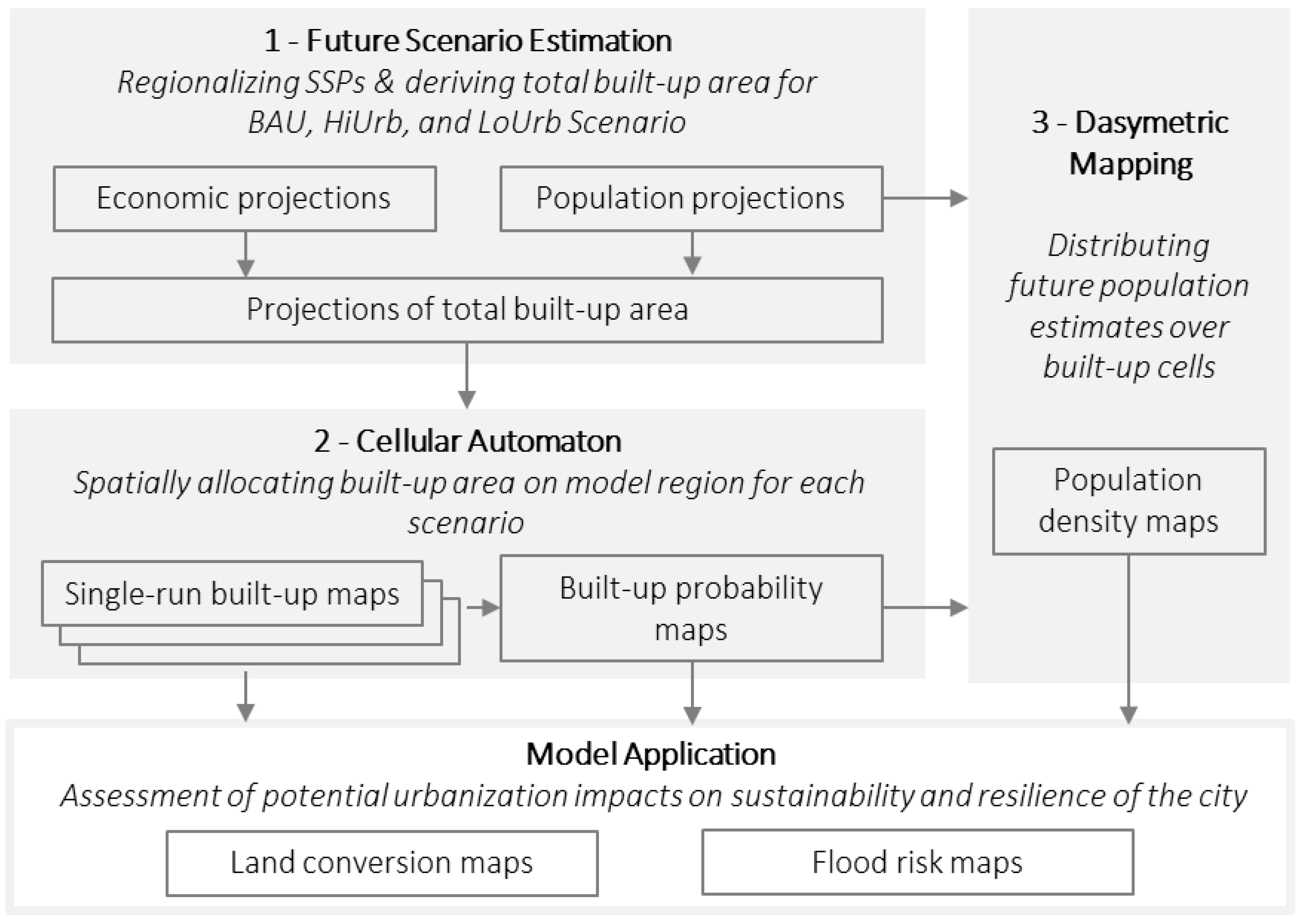
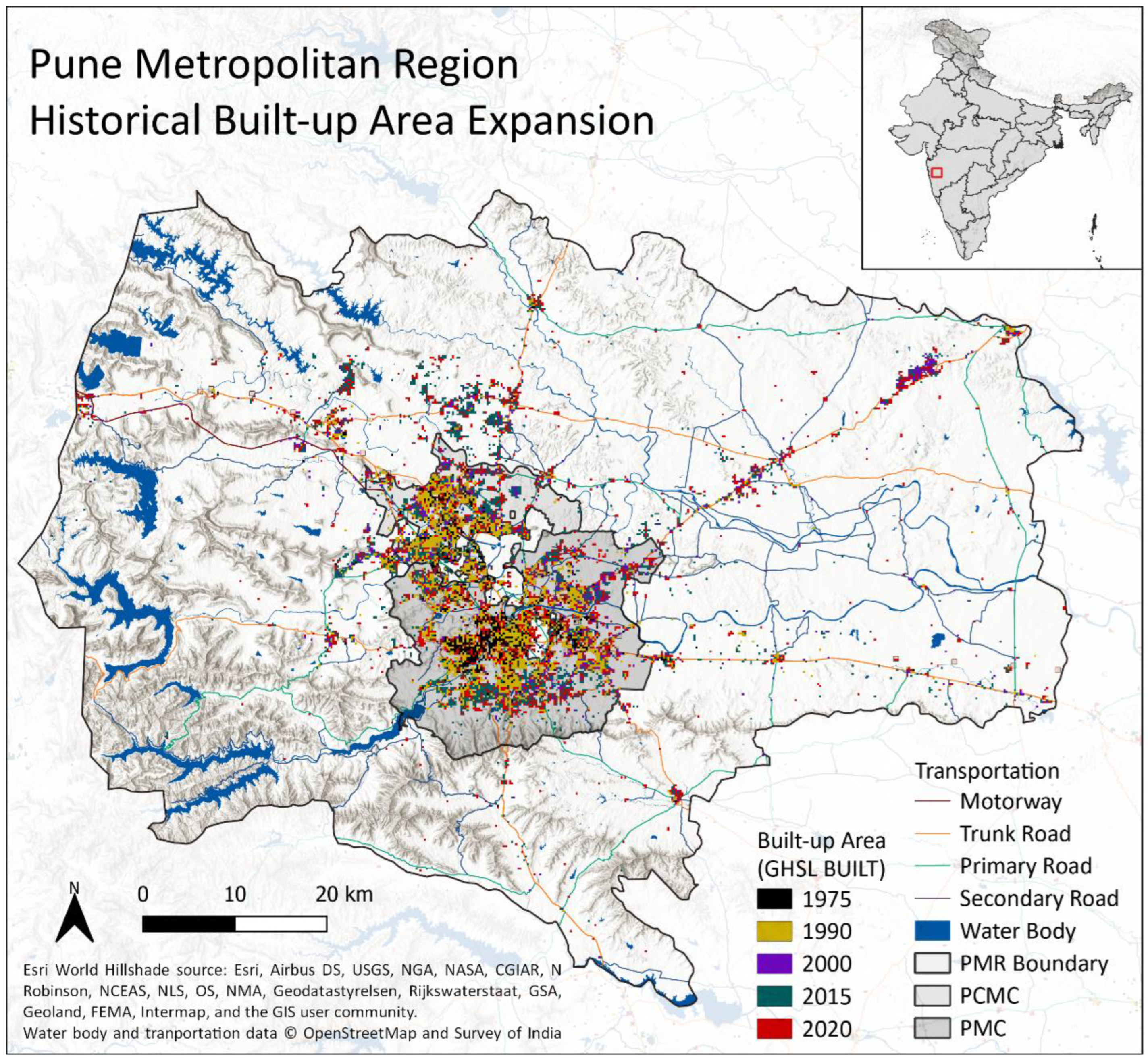

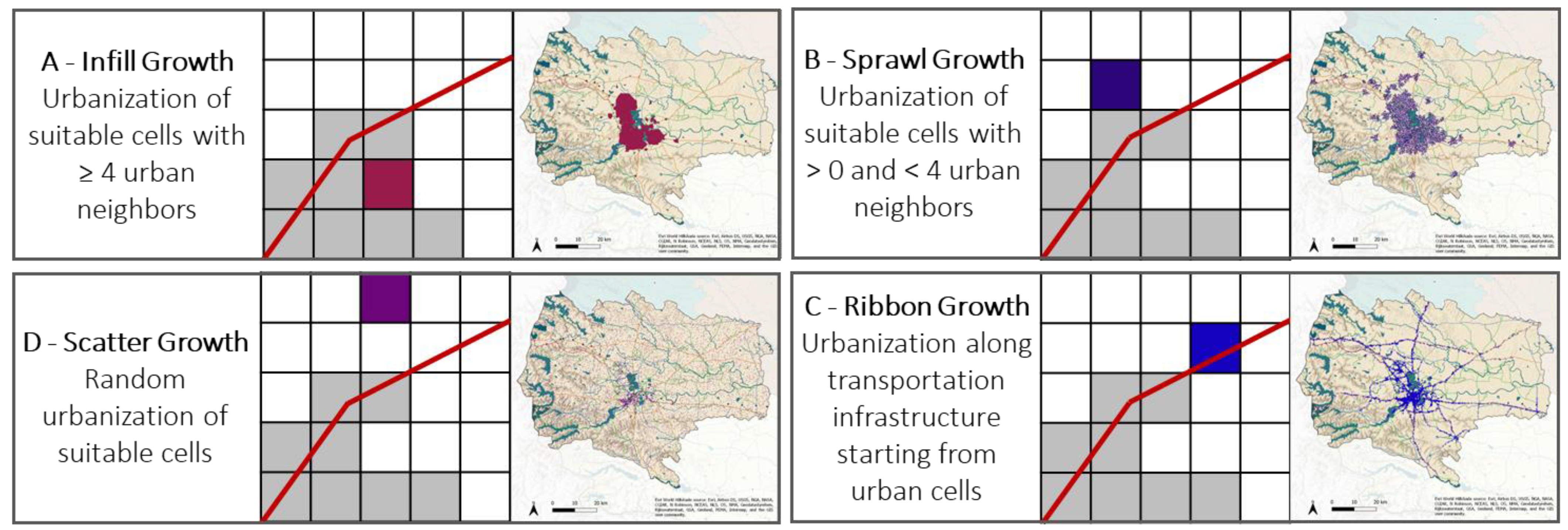
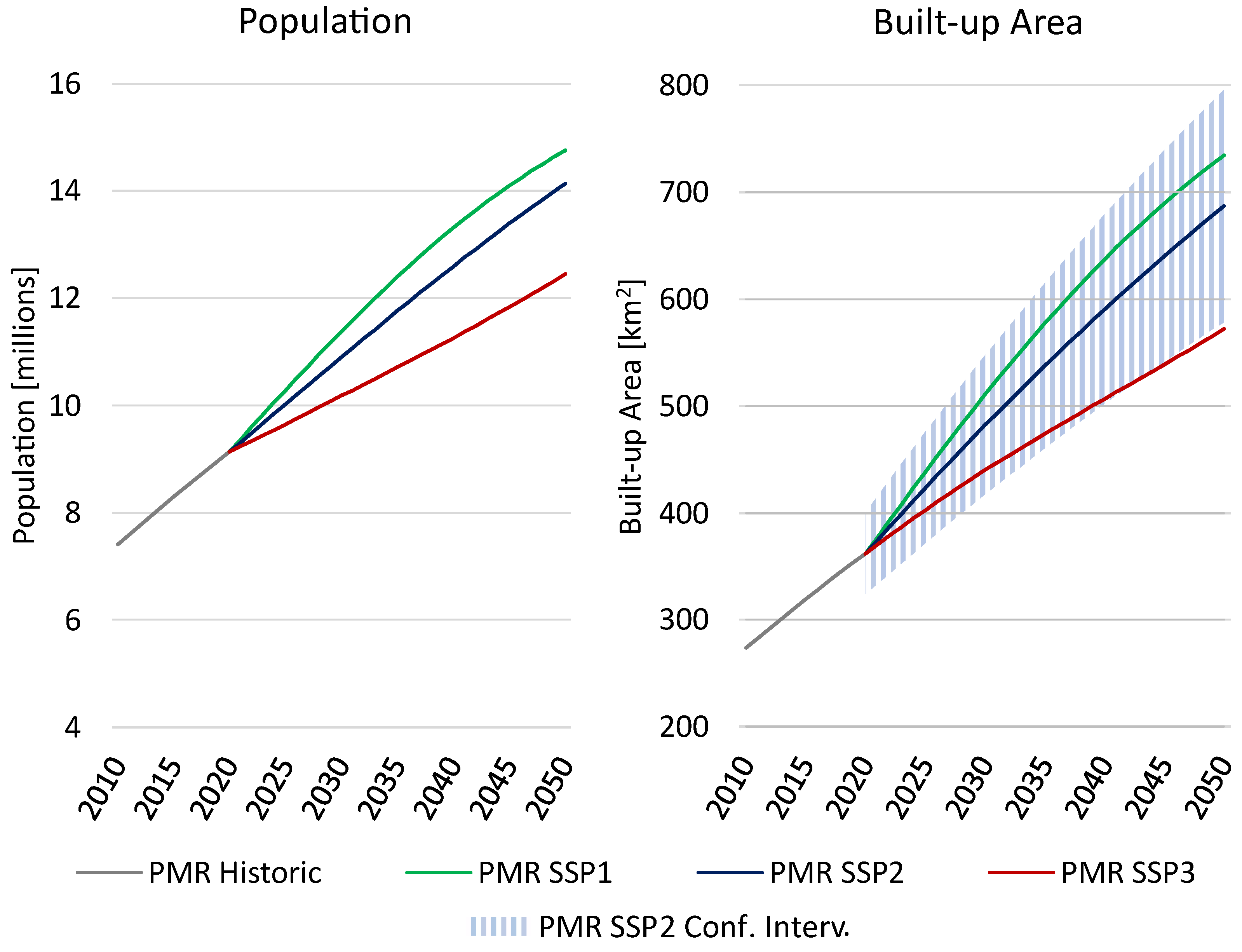


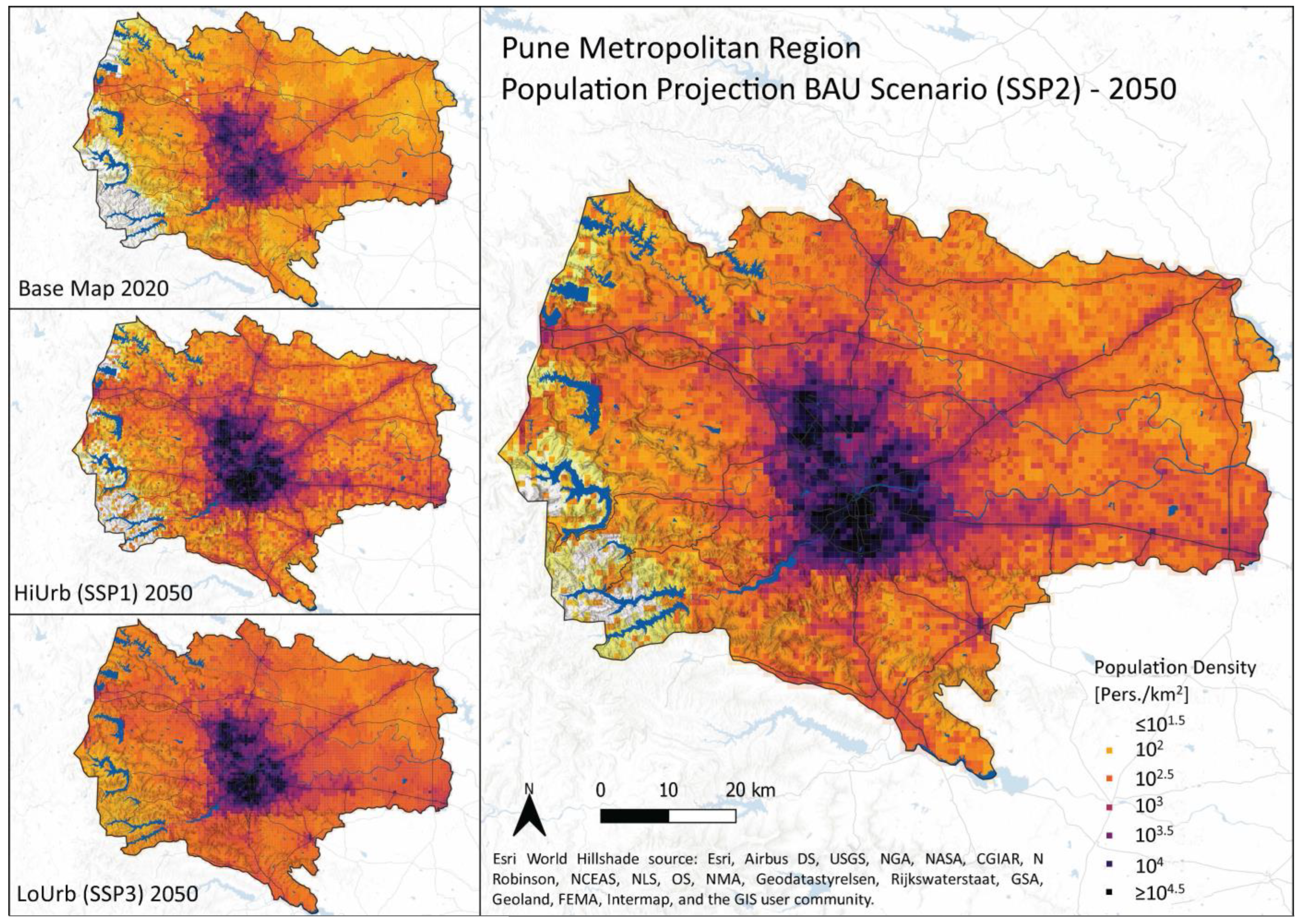
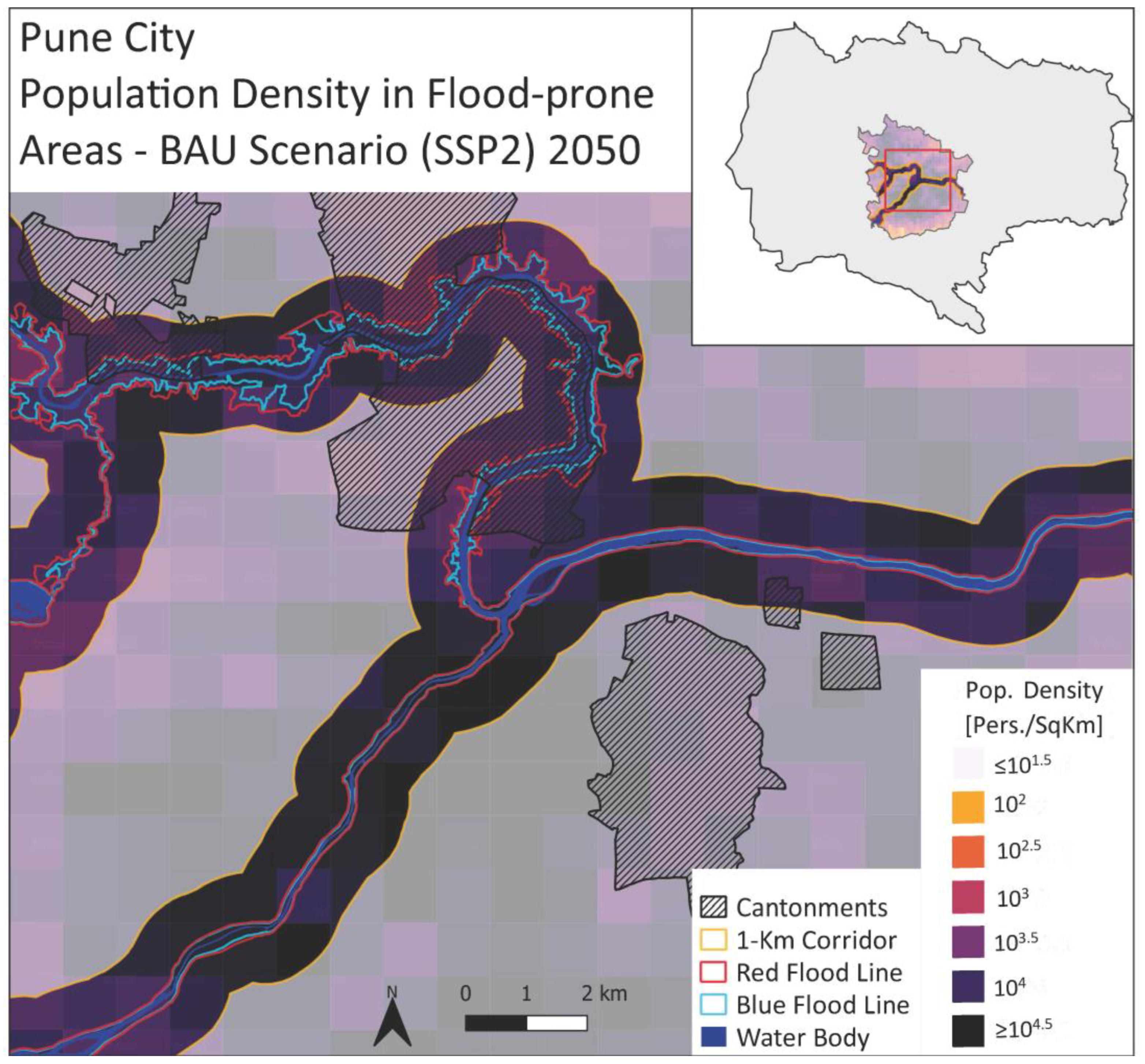
| Data | Description | Source |
|---|---|---|
| Slope layer | Hill slope (%) derived from Cartosat DEM | [73] |
| Exclusion layer | Areas excluded from urbanization. Defined by OpenStreetMap’s land-cover/land-use classes water body and military, as well as protected areas as per the IUCN database. | [74,75] |
| Transportation layer | Historical and current road and railroad network, as well as major infrastructure projects under construction (Pune metro, PMR ring road), based on digitized/geo-located SOI Toposheets, OpenStreetMap, and Planning documents. Years: 1975, 1990, 2000, 2030 | [75,76] |
| Observed urban extent | Multi-temporal raster layer of built-up area. Global Human Settlement Layer (GHSL BUILT). Years: 1975, 1990, 2000, 2014, 2015, 2020 | [2,50] |
| Population distribution | Spatially distributed population derived from Global Human Settlement Population Layer (GHSL POP) 2020. | [42] |
| Census data | Administrative boundaries within the PMR on village/ward level and associated census data. | [48] |
| Land cover | Land cover base map for calculation of urban land conversion: ESA WorldCover | [77] |
| Flood lines | Digitized/geo-located blue and red flood lines issued by Pune Flood Control | [78] |
| Coefficient | Estimate | Std. Error | z-Value | p-Value |
|---|---|---|---|---|
| (Intercept) | 9.74348 | 0.36972 | −26.35 | <2 × 10−16 |
| log(POP_norm) | 1.19208 | 0.03357 | 35.51 | <2 × 10−16 |
| log(DDPpc) | 0.14115 | 0.03621 | 3.90 | 9.68 × 10−5 |
| A | Suitability Parameters | Growth Parameters | Self-Modification Parameters | |||||||
|---|---|---|---|---|---|---|---|---|---|---|
| Slope Resist. | Gravity | Infill | Sprawl | Ribbon | Scatter | Form Change | Suitabil. Change | |||
| Calibrated Value | 3.9 | 15.0 | 50.8 | 44.5 | 47.7 | 83.6 | 3.9 | −47.7 | ||
| B | Total Score | |||||||||
| Calibration Result | 96.8% | 72.9% | 67.1% | 96.9% | 88.6% | 40.7% | ||||
| Base Year | BAU (SSP2) | HiUrb (SSP1) | LoUrb (SSP3) | |||||||
|---|---|---|---|---|---|---|---|---|---|---|
| 2020 | 2030 | 2040 | 2050 | 2030 | 2040 | 2050 | 2030 | 2040 | 2050 | |
| Population [millions] | 9.1 | 10.9 | 12.6 | 14.1 | 11.4 | 13.3 | 14.8 | 10.2 | 11.3 | 12.5 |
| Change to 2020 [%] | - | 19 | 38 | 55 | 25 | 46 | 61 | 11 | 23 | 36 |
| DDPpc [1000 INR2010] | 215.5 | 415.9 | 579.8 | 707.7 | 449.0 | 655.3 | 834.6 | 371.8 | 462.9 | 500.4 |
| Change to 2020 [%] | - | 93 | 169 | 228 | 108 | 204 | 287 | 73 | 115 | 132 |
| Built-up Area [km2] | 362.2 | 482.0 | 590.4 | 687.2 | 510.7 | 637.3 | 734.4 | 440.1 | 506.6 | 571.9 |
| Change to 2020 [%] | - | 33 | 63 | 90 | 41 | 76 | 103 | 22 | 40 | 58 |
| Total PMC and PCMC | Blue Flood Line | Red Flood Line | 1 km Corridor | |||||
|---|---|---|---|---|---|---|---|---|
| 2020 | 2050 | 2020 | 2050 | 2020 | 2050 | 2020 | 2050 | |
| Built-up Area [km2] | 327.00 | 493.89 | 4.90 | 8.55 | 6.61 | 11.48 | 47.40 | 73.45 |
| Increase [%] | 51% | 75% | 74% | 55% | ||||
| Population [in 1000] | 6997 | 10,852 | 146 | 243 | 193 | 322 | 1269 | 2164 |
| Increase 2020–50 [%] | 55% | 66% | 67% | 70.6% | ||||
Disclaimer/Publisher’s Note: The statements, opinions and data contained in all publications are solely those of the individual author(s) and contributor(s) and not of MDPI and/or the editor(s). MDPI and/or the editor(s) disclaim responsibility for any injury to people or property resulting from any ideas, methods, instructions or products referred to in the content. |
© 2023 by the authors. Licensee MDPI, Basel, Switzerland. This article is an open access article distributed under the terms and conditions of the Creative Commons Attribution (CC BY) license (https://creativecommons.org/licenses/by/4.0/).
Share and Cite
Karutz, R.; Klassert, C.J.A.; Kabisch, S. On Farmland and Floodplains—Modeling Urban Growth Impacts Based on Global Population Scenarios in Pune, India. Land 2023, 12, 1051. https://doi.org/10.3390/land12051051
Karutz R, Klassert CJA, Kabisch S. On Farmland and Floodplains—Modeling Urban Growth Impacts Based on Global Population Scenarios in Pune, India. Land. 2023; 12(5):1051. https://doi.org/10.3390/land12051051
Chicago/Turabian StyleKarutz, Raphael, Christian J. A. Klassert, and Sigrun Kabisch. 2023. "On Farmland and Floodplains—Modeling Urban Growth Impacts Based on Global Population Scenarios in Pune, India" Land 12, no. 5: 1051. https://doi.org/10.3390/land12051051
APA StyleKarutz, R., Klassert, C. J. A., & Kabisch, S. (2023). On Farmland and Floodplains—Modeling Urban Growth Impacts Based on Global Population Scenarios in Pune, India. Land, 12(5), 1051. https://doi.org/10.3390/land12051051







